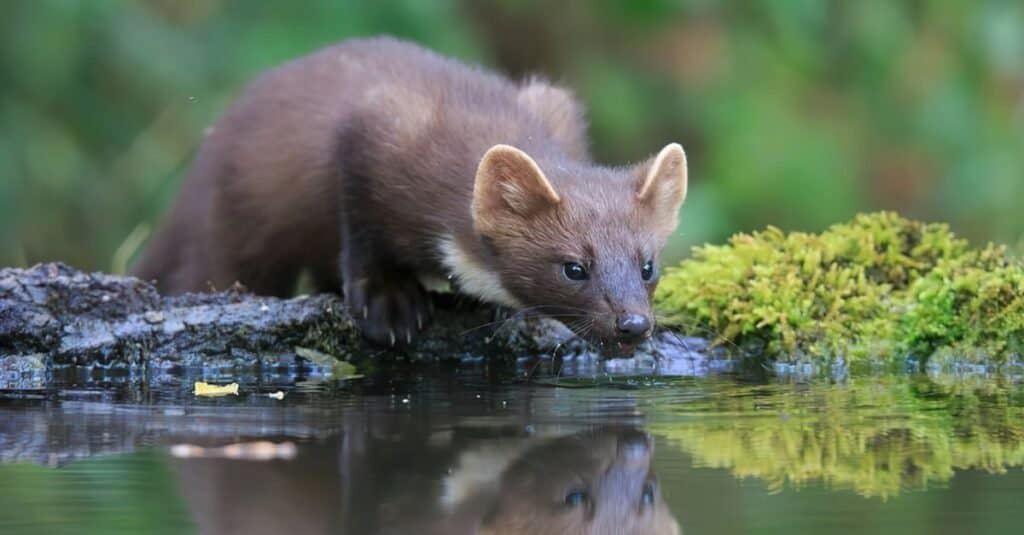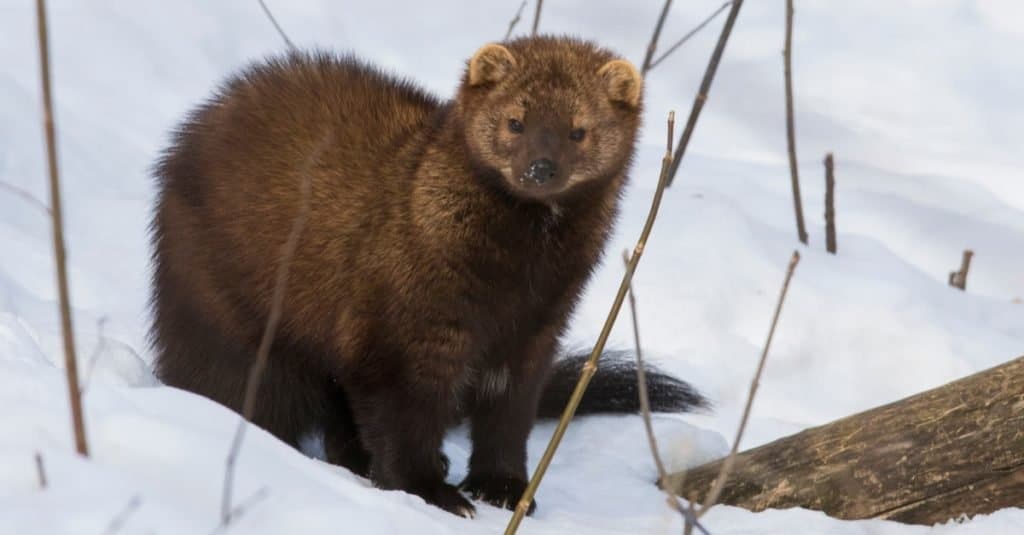Fisher
Pekania pennanti
The fisher is an agile climber and makes its home in tree hollows.
Advertisement
Fisher Scientific Classification
- Kingdom
- Animalia
- Phylum
- Chordata
- Class
- Mammalia
- Order
- Carnivora
- Family
- Mustelidae
- Genus
- Pekania
- Scientific Name
- Pekania pennanti
Read our Complete Guide to Classification of Animals.
Fisher Conservation Status
Fisher Facts
- Prey
- Rodents, hares, shrews, porcupines, birds, fruits, mushrooms, and nuts
- Name Of Young
- Kits
- Group Behavior
- Solitary
- Fun Fact
- The fisher is an agile climber and makes its home in tree hollows.
- Estimated Population Size
- 100,000
- Biggest Threat
- Hunting and habitat loss
- Most Distinctive Feature
- Its dense, luxurious coat of fur
- Other Name(s)
- Fisher, black cat, black fox, and pekan
- Gestation Period
- 10-12 months
- Litter Size
- 1-6 kits
- Habitat
- Forests
- Predators
- Bobcats, lynxes, foxes, and hawks
- Diet
- Omnivore
- Type
- Mammal
- Common Name
- Fisher
- Number Of Species
- 1
- Location
- North America
Fisher Physical Characteristics
- Color
- Brown
- Black
- White
- Gold
- Silver
- Skin Type
- Fur
- Lifespan
- Up to 10 years
- Weight
- 4-13 lbs
- Height
- Up to 30 cm (12 in)
- Length
- 19-30 inches
- Age of Sexual Maturity
- 1-2 years
- Age of Weaning
- 8-16 weeks
View all of the Fisher images!
The fisher is secretive and difficult to find; many misconceptions about them still thrive.
These misconceptions begin with the name itself: the fisher, sometimes called a “fisher cat,” is not a cat at all, but a mammal belonging to the same family as the weasel. It also does not eat fish of any kind. Instead, the name seems to derive from its resemblance to the European polecat (also known as a fiche in French). Early European biologists drew a natural comparison to the animal they were already familiar with. By the 20th century, human activity had dramatically reduced the natural range of this mammal, which often is referred to as a fisher, but recent improvements in their numbers may be forcing them into closer proximity with people.

4 Incredible Fisher Facts
- The fisher is one of the few predators that can successfully take on a porcupine. Its main strategy is to run circles around the porcupine to exhaust it, then it will bite the porcupine in the face. Even the occasional quill attack doesn’t seem to deter it much from preying on porcupines.
- Like other members of the weasel family, the fisher has a reputation for its ferocity. It has been known to triumph over animals twice its size in a fight, including the lynx.
- Fisher ancestors probably originated in Asia and then migrated to North America at some point in the past few million years. The evidence suggests that its range once extended farther south than it currently does.
- A minor league baseball team from Manchester, New Hampshire goes by the name of the New Hampshire Fisher Cats.

The fisher is one of only a few predators that will take on a porcupine and win.
©Warren Metcalf/Shutterstock.com
Scientific Name
The scientific name of the fisher is Pekania pennanti. It was named in honor of the Welsh nationalist Thomas Pennant, who described the animal in 1771 (though he was by no means the first to do so).
There is some debate about the fisher’s genus. Taxonomists used to place it in the genus of Martes, along with the American marten, European pine marten, etc. But based on genetic analysis, taxonomists are now more inclined to place it in a separate genus, Pekania, of which it’s the only living member. Pekania derives from the native Abenaki term for this animal.
The fisher belongs to the Mustelidae Family, which includes carnivorous mammals such as weasels, badgers, otters, and wolverines.

This fisher used to be classified in the same genus as the pine marten.
©Beata Farkas/Shutterstock.com
Evolution and History
Evidence of two extinct species called Pekania palaeosinensis and Pekania anderssoni that belonged to the same family as the fisher has been found in eastern Asia. This, combined with confirmation the first fisher, Pekania diluviana, was in Middle Pleistocene of North America, suggests the fisher’s ancestors moved to North America between 2.5 million and 5 million years ago during the Pliocene era. Fossils show the fisher was found in areas farther south that its modern-day habitats.
While three subspecies — Martes pennanti columbiana, M. p. pacifica, and M. p. pennanti — were previously identified, in 1959 it was determined that they were not distinguishable by fur or skull characteristics and it is now generally accepted the fisher has no subspecies.

It’s believed the fisher’s ancestors moved to North America between 2.5 million and 5 million years ago.
©Holly Kuchera/Shutterstock.com
Appearance
The fisher shares many physical similarities in common with the closely related marten and other members of the weasel family. These include a long, lithe body (low to the ground), short legs, a big, bushy tail, rounded ears, and a tapered muzzle. The feet are large and padded, which allows them to move ably across the light snow, and contain retractable claws.
The coat usually comes in various shades of brown, ranging from light to dark, with gold or silver markings around the head and shoulders. Both the color and density of the coat may differ between individuals and even between the seasons. Summer brings a kind of mottled appearance, as the fisher undergoes the molting process, whereas the coat is thickest and darkest during the winter.
The body of adult fishers measures between 20 and 25 inches long (about the same size as the short-legged Dachshund); the tail adds another 13 to 16.5 inches. Altogether, the entire animal weighs between 3 and 15 pounds. Males are generally larger and also have coarser hair than females. Otherwise, their physical appearance is similar.

The fisher’s coat is the thickest and darkest during the winter.
©Mircea Costina/Shutterstock.com
Behavior
The fisher’s naturally reclusive nature has made it somewhat difficult to study in the wild. From what we understand, it appears to be a solitary species that maintains a defined territory a few square miles large. The fisher does not generally interact with other members of the same species outside of the breeding season. This is supported by the fact that male fishers in particular tend to be quite aggressive toward each other. However, the home range of a male may overlap with the range of a few females, which helps facilitate interactions in the breeding season.
Fishers mostly rely upon their excellent sense of smell, hearing, and sight to interact with the world around them and find suitable prey. They are active all year round and probably do most of their hunting in the twilight hours. Scent markings appear to be the main means of communication with other members of the same species.
To the extent that most people know about fishers at all, it’s commonly assumed that they make a loud screaming sound, but the evidence for this is limited. Most of the time, what people may be hearing is the loud screaming sound of the red fox. When fishers make any sounds at all, it’s usually a chuckling or growling kind of vocalization.
One characteristic that would make the fisher comparable to a domestic cat is its ability to climb. Fishers can climb trees, though it’s more common to find them on the ground. The ankle joints in their hind paws are rotational, which allows them to climb down a tree head-first–a skill very few mammals possess.

Male fishers tend to be more aggressive toward other males of the species.
©Reimar/Shutterstock.com
Habitat
The fishers are native to the northern boreal and mixed forests of the United States and Canada, stretching from the Atlantic to the Pacific coasts. Their range extends as far south as the Sierra Nevada in California and perhaps even to the Appalachians in Virginia, although they do not occur in the prairies or the south.
Fishers prefer to keep a year-round nest in hollow sections of trees high up in the canopy, where they’re generally safe from threats. Fishers also use stumps, holes, brush piles, and branches strewn around their territory as resting sites. Ground burrows with long, narrow tunnels are generally maintained in the winter.

Fishers nest in trees high up in the canopy.
©Holly Kuchera/Shutterstock.com
Predators and Threats
Habitat loss and hunting appear to be the main threats to the fisher. Since the 18th century, European trappers have prized the quality of their winter fur for the creation of scarves and neckpieces. This has also coincided with the loss of forest habitats in many areas of North America. Population numbers likewise fell over the same time period.
In Minnesota, the fisher population has declined by some 50% and has yet to recover. One problem is that fishers rely on old or mature trees with a large enough hollow to fit inside. Logging continuously disrupts their natural habitat.
Fishers are sometimes preyed upon by foxes, bobcats, lynxes, and hawks. An adult fisher is generally large and aggressive enough to avoid predation, but the juveniles are far more vulnerable to danger.

The fox is one animal that preys on the fisher.
©Giedriius/Shutterstock.com
Diet
The fisher will eat almost anything it feels confident enough to hunt. Its carnivorous diet primarily consists of rodents, hares, shrews, porcupines, and birds, sometimes supplemented with fruits, mushrooms, and nuts. It also won’t pass up an easy meal from a dead carcass.
The fisher is one of the few predators long and flexible to fit inside holes and hollows while simultaneously possessing the ability to climb trees with excellent speed and agility.

Hares form part of the fisher’s diet.
©RRichard29/Shutterstock.com
Reproduction and Life Cycle
There is still a lot we don’t know about the fisher’s mating practices, including how it attracts a mate and how long they remain together. From all the information scientists have gathered, we do know that its mating season generally lasts between the late winter and early spring. This timing can vary somewhat by location.
Once the fisher has mated, the female has the unusual ability to delay the implementation of the fertilized egg until the next reproductive cycle. The embryo can remain in this state of suspended development for up to 10 or 11 months, while the actual embryonic development only lasts about a month or two. After a long gestation period lasting almost a year, the mother will finally produce a litter of one to six kits at a time. Each baby is born completely blind and helpless, weighing a mere 40 grams each, with only a very fine coat of hair.
The mother bears sole responsibility for raising the baby kits, while the father plays no role at all. The kits will depend on her for everything until their eyes begin to open after about 50 days. It takes about eight to 16 weeks before they are fully weaned from their mother’s milk, and by the four-month mark, she has most likely taught the baby kits how to hunt. They will disperse from the den about a month later.
Females will start to become sexually active after their first year. Due to the fact that they can suspend embryonic development for nearly a year, and can mate again almost immediately after giving birth, they spend almost all of their adult lives in a state of perpetual pregnancy or lactation. Males, by contrast, take about two years to reach full sexual maturity and devote only a small portion of their lives to reproduction. If they end up surviving their juvenile phase, then fishers can live up to 10 years in the wild.

At four months, the fisher has learned how to hunt and will leave the den aged around five months.
©Holly Kuchera/Shutterstock.com
Population
The fisher is currently classified as a species of least concern by the IUCN Red List. It is estimated that around 100,000 fishers still remain in the wild. With the decline of the fur trade and the restoration of some parts of its former habitat, the prospects for the fisher have improved considerably, but it still may be under threat in certain areas of North America.
View all 91 animals that start with FFisher FAQs (Frequently Asked Questions)
What is a fisher?
The fisher is a type of somewhat arboreal mammal with a long body, short legs, and dense, dark fur. As a member of the weasel family, it’s closely related to the marten.
Are fishers carnivorous, herbivorous, or omnivorous?
The fisher is actually omnivorous, but the bulk of its diet consists mainly of carnivorous meat. Fruits and other plant matter are a supplement to its normal diet.
What does a fisher sound like?
Fishers will make a subtle chuckling or growling sound, but smell appears to be its main means of communication, not vocalizations.
Are fishers dangerous?
Aggressive encounters are very rare. The fisher will only ever attack a person if it feels threatened or scared. People can avoid encounters with fishers by taking care of garbage, pet food, or any other food that might attract it.
Why do fishers scream?
There is actually minimal evidence to support the notion that fishers scream. This sound is probably made by a fox and then misattributed to the fisher.
Where do fishers live?
Fishers mostly reside in forests and the hollows of trees. Their range extends across the northern United States and parts of Canada.
Can a fisher kill a human?
There is no evidence that a fisher has ever killed a human, but there have been reports of attacks on young children and domesticated animals, mostly against cats. These are exceptionally rare; fishers will almost always try to avoid contact with other animals that may pose a threat to them. As fishers become more common, though, they may be much bolder about wandering into suburban areas.
What do the fisher tracks look like?
The fisher’s front tracks measure 2.5 to 4 inches wide. It actually has five toes and a C-shaped metacarpal pad, but the innermost toe may not always leave behind an imprint. The hind tracks are very similar, except they measure 2 to 3 inches in width.
What are the differences between pine martens and fishers?
The differences between pine martens and fishers include size, appearance, diet, predators, threats, behavior, habitat, reproduction, and lifespan.
Thank you for reading! Have some feedback for us? Contact the AZ Animals editorial team.
Sources
- Britannica, Available here: https://www.britannica.com/animal/fisher-mammal
- Animal Diversity Web, Available here: https://animaldiversity.org/accounts/Martes_pennanti/
- The New York Times, Available here: https://scientistatwork.blogs.nytimes.com/2011/02/14/the-silence-of-the-fishers/
- Live Science, Available here: https://www.livescience.com/fisher-cats.html
- Winterberry Wildlife, Available here: https://winterberrywildlife.ouroneacrefarm.com/2020/01/30/fisher-tracks-and-sign/

















